Digital Exhibitions
The purpose of the Gallery Gateway is to make exhibition content available to those who cannot visit The Rosenbach in person, and to create a permanent record of the information shared in exhibitions.
Gallery Gateways provide all of the content presented on-site in The Rosenbach’s exhibitions via an easily-accessible, easy-to-print, online format. The Gallery Gateway is a cross between traditional, printed museum exhibition catalogues and web-based virtual exhibitions, which have become popular in recent years.
Gallery Gateways present a large amount of visual and text–based content in a PDF format that makes exhibition content as accessible as possible across audiences and digital interfaces. The Gateways can be viewed online or downloaded to a personal device for viewing and printing.
On this Gallery Gateway Online Exhibition Portal, you will also find other special features, including sound effects for web listening, digital interactives, gallery graphics, interviews, and video content. Check the Portal for enhanced digital features as more Gallery Gateways go live.

Succession: Why Presidential History Matters Now
As the United States enters another contentious and consequential presidential election cycle, we explore fundamental questions about the history and future of the highest office in the land.

The Global Other: Race and Empire in James Joyce’s Ulysses
Join The Rosenbach for an examination of how James Joyce’s famous novel Ulysses speaks to contemporary conversations about the long-term legacies of colonialism and imperialism.

American Voyager: Herman Melville at 200
Explore the life, works, and complex legacy of Herman Melville, author of the iconic Moby-Dick. Making use of The Rosenbach’s extensive Melville holdings and numerous loans from partner organizations, including rare manuscripts and first editions, the exhibition examines how Melville fled to the watery fringes of 19th-century life to grasp core truths about American society—and even human nature itself.

Manjiro: Drifting, 1841–2020
Manjiro’s epic tale begins in 1841, when, as a teenager, he left his tiny Japanese village on a fishing trip. A violent storm left him shipwrecked and set the course that would lead Manjiro to become the first Japanese person to live in the United States. In partnership with the Japan America Society of Greater Philadelphia’s JapanPhilly2020 initiative

The Rights of Woman: Gender in Robert Burns’s Enlightenment
Robert Burns had a complex relationship with the women in his life. He wrote legendary love poetry, engaged in spirited intellectual dialogue with female thinkers, and damaged the opportunity and social mobility of some women by his privileged approach to intimate relationships.

Out of Many, One: Diversity and the American Experiment
The American experiment in democratic government brings together all kinds of people to participate in civic life. This display of rare books, manuscripts, and artworks highlights a diversity of individual experiences in our country’s history, from the founding of Plymouth Colony through the turmoil of the Civil War.

In The Beginning: Three Jewish Firsts From The Rosenbach Collection
The Rosenbach’s co-founder Dr. A.S.W. Rosenbach assembled three astonishing collections that document Jewish firsts: the first Hebrew printed books in the world, the first books by and about Jewish Americans, and the artifacts of the Gratzes, one of Philadelphia’s earliest and most prominent Jewish families.

